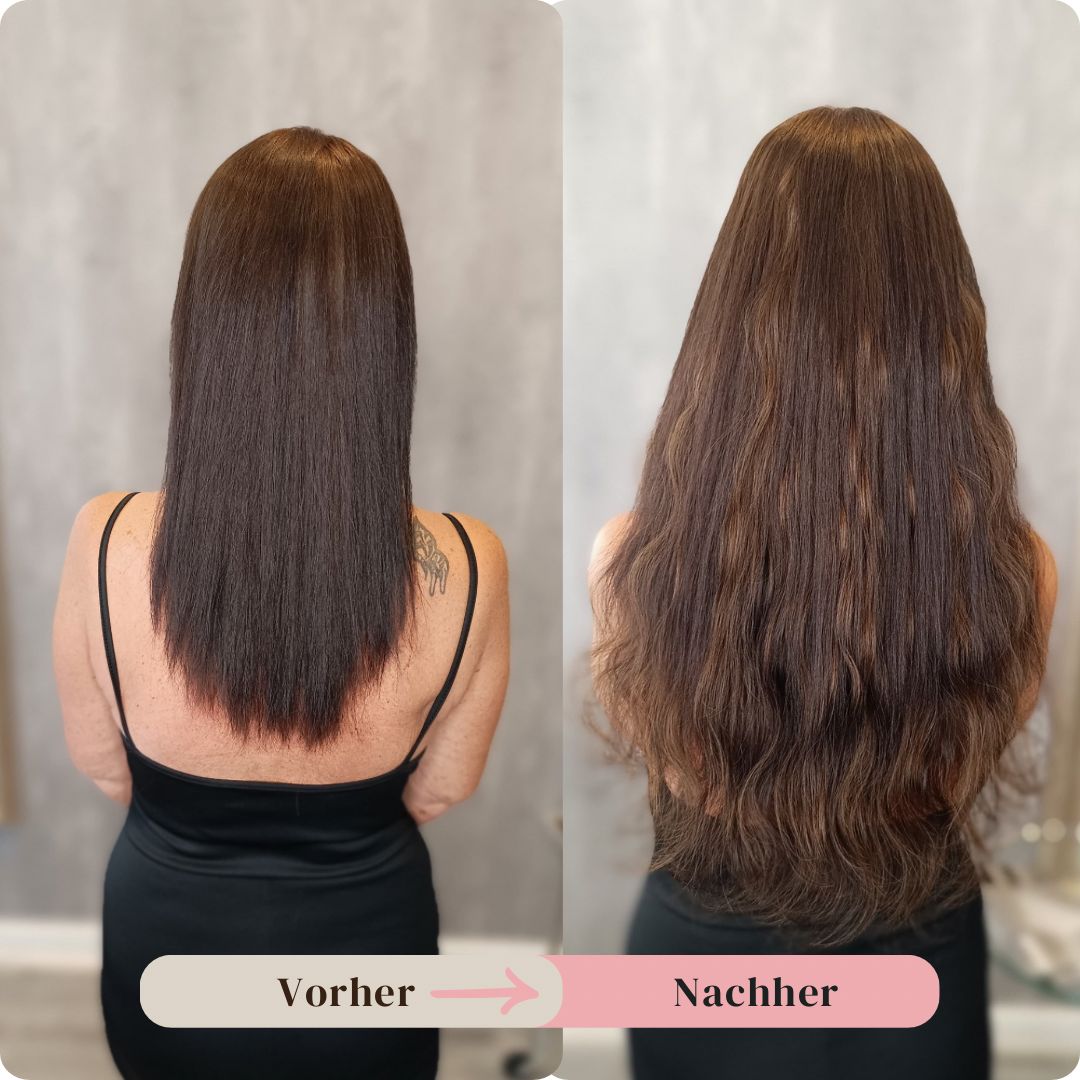Blog
Insert bonding: The ultimate guide to perfect keratin extensions (2025)

Would you like to learn how to use bonding correctly?
Then this guide is just right for you.
Because today I'm going to show you the Precise step-by-step instructionswhich I have developed in over 10 years as an extension professional.
The best thing about it?
This method also works if you have never used bonding before.
Let's dive in.
What are bondings and why are they so popular?
Bondings are small keratin plates that permanently connect your extensions to your own hair. This method has become the absolute number one in professional hair extensions in recent years, and for good reason.
The decisive advantage lies in the exceptional durability of three to six months when used correctly. In contrast to clip-in extensions or other temporary solutions, bondings are integrated completely invisibly into your own hair. The bonds at the hairline are so discreet that no extension technique is recognisable, even when the hair is pinned up.
What makes bonding so special is the natural movement of the hair. You can go swimming, do sports, sleep normally and style your hair without having to worry too much about the extensions. The keratin bonds are so stable that they can withstand all everyday stresses and strains.
But here's the problem: 95% of all beginners make critical mistakes when bonding, leading to premature falling out or even hair damage. These mistakes not only cost money, but can also permanently destroy confidence in extensions.
The good news? With the right technique and the knowledge I'm sharing with you today, you can avoid these mistakes completely and achieve professional results.
The 3 most common bonding mistakes (and how to avoid them)
Error #1: Insufficient preparation
The problem: You place the bondings directly on unprepared hair.
Why it goes wrong: Styling residues and silicone deposits prevent adhesion.
The solution: Use two washes with deep cleansing shampoo before bonding.
Error #2: Incorrect temperature
The problem: You work without temperature control.
Why it goes wrong: Temperature too low = weak connection. Temperature too high = hair damage.
Error #3: Overfilling
The problem: You are setting too many bondings at once.
Why it goes wrong: The hair looks unnatural and stresses the scalp.
The solution: Maximum 200-300 bondings, depending on hair density.
The tool checklist: What you need for bonding
Before you start the actual bonding process, you need to make sure you have the right equipment. Here is an area where many beginners make the crucial mistake: they try to work with inferior or unsuitable tools.
A professional heat gun with precise temperature control between 180 and 220 degrees Celsius is absolutely essential. This investment makes the difference between professional results and disaster. Cheap tongs from the internet often have inaccurate temperature readings or uneven heat distribution, leading to weak bonds or hair damage.
Premium Bonding Extensions should never be an area where you skimp. Low quality hair breaks faster, loses its lustre and feels unnatural. Human hair from the Caucasian region is considered the gold standard as it is most similar to European hair texture.
A precision handle comb allows you to create sections with millimetre precision, which is essential for an even result. Extension clips keep the upper sections of hair neatly separated while you work, and heat-resistant gloves protect your fingers from burns when moulding the warm keratin bonds.
Step-by-step: Using bondings correctly
Step 1: Strategic planning
Here's something most people do wrong: they just start somewhere and hope for the best. This approach inevitably leads to inconsistent results and dissatisfied customers.
Professional bonding always starts with a thorough scalp analysis. You need to localise the hair whirls, as the hair grows in different directions in these areas. Bondings that are placed against the natural hair growth do not hold as well and can pull uncomfortably.
Hair density varies greatly from person to person and even on the same head. The back of the head usually has the highest density, while the temples are often thinner. You need to take these differences into account when planning in order to achieve a natural result.
Identifying problem areas is another important aspect. Some people have very sensitive scalps or areas with weaker hair growth. You need to be particularly careful here or avoid these areas altogether.
The distribution plan follows a proven formula: Approximately 50% of the bondings go into the back of the head, approximately 25% per side area. This distribution ensures a natural look and prevents the extensions from becoming too heavy.
Step 2: Mastering the basic technique
Now it's time to get specific with the bonding:
The 8-10mm rule:
- Always place bondings 8-10mm away from the hairline
- Never directly at the base (causes pain)
- Never too far down (becomes visible)
The strand formula:
- Own hair strands = bonding thickness
- For finer hair: thinner strands
- For thick hair: slightly thicker strands
Step 3: The perfect keratin connection
This is the decisive moment when bonding is applied:
- Warming: 8-12 seconds at optimum temperature
- Moulds: Immediately mould the warm keratin with your fingers
- Cool down: Wait 30 seconds before the next bonding
- Testing: Pull lightly - bonding must be tight
Insider trick: If the bonding moves, reheat immediately.
Step 4: Proceed in rows
Using a systematic approach to bonding determines the success or failure of the entire project. Without a clear structure, the results will be uneven and immediately recognisable as artificial.
The first row at the nape of the neck is the foundation of your work. The line should run about two to three centimetres above the hairline and follow the shape of the head. Even small deviations will be visible later on, especially with upswept hairstyles.
For the subsequent rows at the back of the head, it is crucial to place the bondings offset to the bottom row. Placing bonds directly on top of each other is a cardinal mistake that leads to unnatural edges and an unnatural appearance.
The top row at the back of the head is also very important as it creates a natural transition. Many hairdressers overdo it in this area, resulting in an unnatural look. You need to work particularly carefully here, as incorrectly placed bonds will be immediately visible. The bondings in this area should be smaller than in the lower rows.
Step 5: Mastering side areas
Use the supreme discipline in bonding:
Temple area:
- At least 2 cm from the face
- Work with micro or nano strands if necessary
- Fewer bondings than at the back
- Natural look guarantee
Quality control: The 7-point check
I always carry out a thorough quality check after bonding. This systematic check has helped me to deliver consistently perfect results for over ten years.
Firstly, I check that all the keratin bonds are firm and even. Each individual bond must feel stable and must not move when lightly pulled. Differently sized or unevenly shaped bonds are immediately noticeable and must be repaired.
The visibility check is particularly important. If the client ties her hair up or puts it in a plait, no bondings should be visible. This test immediately shows whether you have chosen the right placement.
Natural hair movement must be guaranteed. Extensions should move in the same way as your own hair. Stiff or unnaturally hanging strands indicate errors in distribution or bondings that are too heavy.
Pressure marks on the scalp are an absolute no-go. The customer must not feel any discomfort anywhere, neither directly after the treatment nor in the days that follow. Bondings that are too tight can lead to headaches and even hair loss.
The length distribution must be even, without visible steps or edges. Uneven lengths make the extensions look artificial and immediately give away the fact that they are hair extensions.
All bondings must be smooth to the touch, without rough edges or protruding keratin residue. These would get caught in other hairs and pull unpleasantly when combing.
Finally, I test whether the client can move her head without any problems. Restricted mobility indicates too many or too heavy bondings. If even a single point is not right, it will be corrected. There are no compromises in professional work.
The first 48 hours: Critical phase
After bonding, the first 48 hours are absolutely crucial for the longevity of the extensions. During this time, the keratin hardens completely and forms the final bond with your own hair. Any mistake in this phase can ruin hours of perfect work.
The most important rule is not to wash your hair for the first two days. This may be unusual for many clients, but the keratin needs this time to reach its maximum strength. Water and shampoo would disrupt this process and weaken the bonds.
Tight ponytails or braids are taboo during this phase. Pulling on the fresh bonds can loosen or even loosen the bonds that have not yet fully hardened. Even tying the hair into a loose bun should be avoided.
Extreme care must be taken when brushing. Only special extension brushes with soft bristles should be used, and even then only very gently. Aggressive brushing movements can damage or displace the bondings.
Sleeping on a silk pillow significantly reduces friction and protects both the extensions and your own hair from tangling. Silk pillows are a small investment that pays off in the long term. Alternatively, a silk scarf can be placed over the normal pillow.
Why most people fail when using bonding
The hard truth is: using bonding correctly is an art that requires years of practice and experience. It's not enough to watch a YouTube video or attend a weekend seminar.
The most common reason for failure is a lack of experience in understanding the anatomy of the head. Every head is shaped differently, has different hair growth patterns and individual characteristics. What works for one person may go completely wrong for another. This experience can only be gained through years of practice with hundreds of different clients.
Cheap material is another main reason for disappointment. Low-quality bonds simply don't hold, no matter how perfect the technique is. The keratin comes loose after a few weeks, the hair becomes brittle or discoloured. In the end, you end up paying twice: once for the cheap extensions and then again for the professional touch-up.
The wrong tools are an underestimated problem. Home equipment from the internet may be cheap, but does not work for professional results. Inaccurate temperature settings, uneven heat distribution and poor workmanship lead to weak bonds or hair damage.
The biggest problem, however, is the lack of a systematic approach. Many beginners work haphazardly without understanding the overall composition. They don't see how individual bondings affect the overall picture and the result looks unnatural and artificial.
The solution? Let a professional do it. With Haartick Extensions we only use premium human hair from the Caucasian region and have over ten years of experience in professional bonding. Our bondings last three to six months and come with a guarantee.
My 3-pillar formula for success
After over a decade of experience in bonding, I have developed a formula for success based on three inseparable pillars. This method is the reason why my extensions consistently last three to six months and my clients keep coming back.
The first pillar is perfect preparation. Without the right preparation, everything else involved in bonding is for nothing. This starts with a thorough hair analysis, in which I not only assess the hair structure and density, but also take the client's lifestyle into account. Proper washing with deep cleansing shampoo removes any residue that could affect the bonding. Strategic planning determines exactly where each bond will be placed.
The second pillar is precise execution. This is where the wheat is separated from the chaff. Millimetre-precise placement is not a marketing slogan, but an absolute necessity. A bond that is even a few millimetres out of place can ruin the entire result. Knowing the optimum temperature for each hair type and keeping it constant requires years of experience. The systematic procedure according to proven patterns guarantees consistent quality.
The third pillar is professional aftercare. Many people completely underestimate this aspect. My customers receive detailed care instructions that are specially tailored to their extensions. Follow-up appointments after six to eight weeks ensure that everything fits perfectly. Our customers always have someone to contact if they have any questions or problems.
Using bondings: Costs vs. benefits
Professional bonding costs:
- 600-1500€ (depending on length and quantity)
- 3-6 hours working time
- Refresher required every 3-6 months
Even bonding costs money:
- 200-400€ Material
- Often failure and hair damage
- Time expenditure difficult to calculate
My advice: Have bondings fitted by a professional. The savings are not worth the risk.
Frequently asked questions about bonding
How long do professionally applied bondings last?
If used correctly and cared for properly, bondings last 3-6 months.
Can I apply bonding myself?
Theoretically yes, but I would advise against it. The learning curve is steep and mistakes can be expensive.
Does bonding damage the hair?
No, if used correctly by an expert, no damage will occur.
What happens if bondings are used incorrectly?
Possible consequences: Hair breakage, hair loss, premature falling out of the extensions, uneven appearance, headaches.
Conclusion: use bonding like a pro
Using bondings correctly is a science in itself.
The technique I have shown you here is based on over 10 years of experience and thousands of satisfied customers.
The most important facts in brief:
- Preparation is everything
- Proceed systematically
- Quality before quantity
- Use professional tools
- Don't forget aftercare
Would you like to have bonds inserted that really hold?
Then let's talk.
As an extension expert with over a decade of experience, I guarantee that my bondings deliver what they promise.
Ready for extensions that will change your life?
Then arrange your consultation appointment now and experience what real professional service means.

